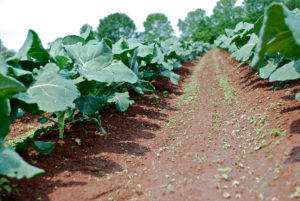Cornucopia’s Take: After years of flatlining, the number of domestic organic farms has finally started to rise. And while organic food accounts for about 5% of all food sales in the U.S., organic farms still only account for about 1% of total farm acreage. Yet many organic family farmers are facing intense pressure from cheap imports and fraud, the rise of factory farms in organic livestock agriculture, and soil-less hydroponics which produces fruits and veggies without having to follow many of the crop and soil fertility building requirements for farmers raising food in the soil. These challenges are threatening the viability of many organic family farms.
Big gains in number of U.S. organic farms, value of organic sales
The FERN
by Chuck Abbott
 |
At a time when U.S. farm numbers are stagnant, the organic sector continues to grow, said a recent report by the USDA. There were 14,217 certified organic farms that sold $7.55 billion worth of organic commodities last year. The number of farms was up 11 percent from the previous year, and total sales were up 23 percent, according to the agency’s Certified Organic Survey.
“The results … show the continued growth and interest in organic foods,” the USDA said. California was the No. 1 organic state by far, with 2,713 farms, 1.07 million acres in production, and $2.9 billion in sales — 38 percent of the U.S. total. Nationwide, milk, eggs, broiler chickens, apples, and lettuce were the top organic commodities by value and, at $3.6 billion, accounted for nearly half of the sales tally.
“Overall growth in sales of organic agricultural production is positive news,” said the Organic Trade Association (OTA). The trade group said the “dramatic growth in livestock products does not parallel growth in livestock feed grains. This underscores the need to shore up import oversight and increase support for domestic grain producers.”
Early this week, an inspector general’s report warned that unscrupulous importers could falsely claim their goods were organic and sell them at a premium. The audit followed a Washington Post story saying that millions of pounds of corn and soybeans were imported as organic despite evidence they were grown using conventional methods. The USDA said it was tightening its control over imports to prevent cheating.
For all its vibrant growth, organics is still a small part of U.S. agriculture. The USDA says there are 2.06 million farms and 911 million acres of farmland in the country. Growth of the organic industry — farms and businesses — has accelerated in the past few years as the economy recovered from the 2008–09 recession. In April, the USDA’s Agricultural Marketing Service, which oversees the organic sector, said there were 24,650 organic operations in the country, up 13 percent from 2015. The Certified Organic Survey, directed solely at producers, is generated by the agency’s National Agricultural Statistics Service and covers a smaller group.
To be certified as organic, producers must go through a three-year transition during which they do not use synthetic fertilizers or pesticides, GMOs, or antibiotics or growth hormones for livestock.
The OTA said there may be 640 more organic producers than the USDA reported, based on data from the third-party agents accredited by the agency to certify producers.
After California, the top states for organic sales were Pennsylvania ($660 million), Washington state ($636 million), and Oregon ($351 million), said the USDA. Wisconsin and New York were the only states besides California with more than 1,000 organic farms — 1,276 in Wisconsin and 1,059 in New York.
The Certified Organic Survey is a recent undertaking by the USDA, which has now conducted three surveys of certified producers.


